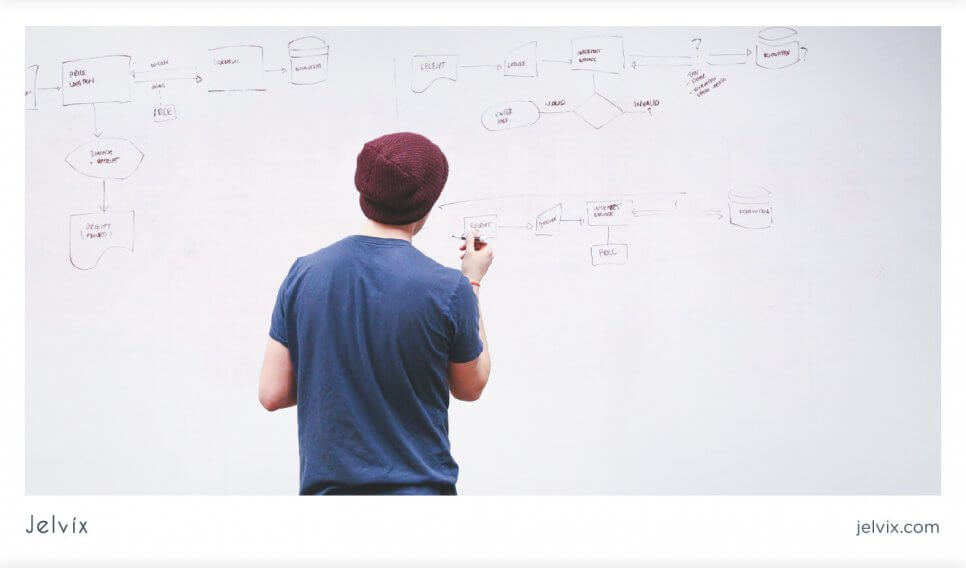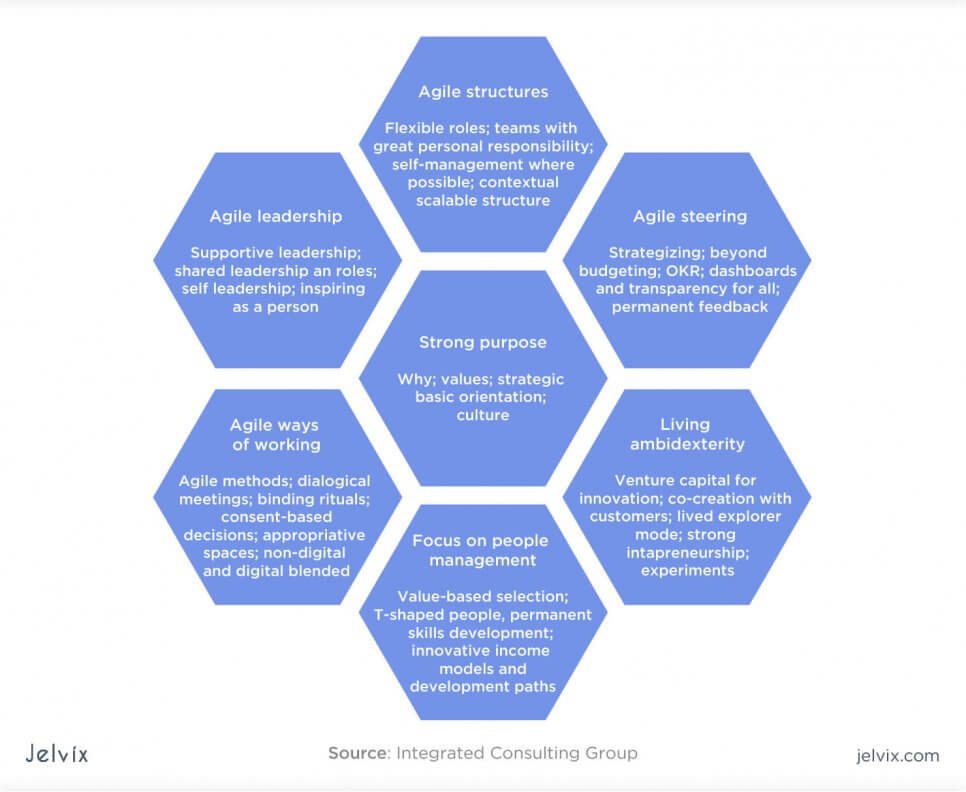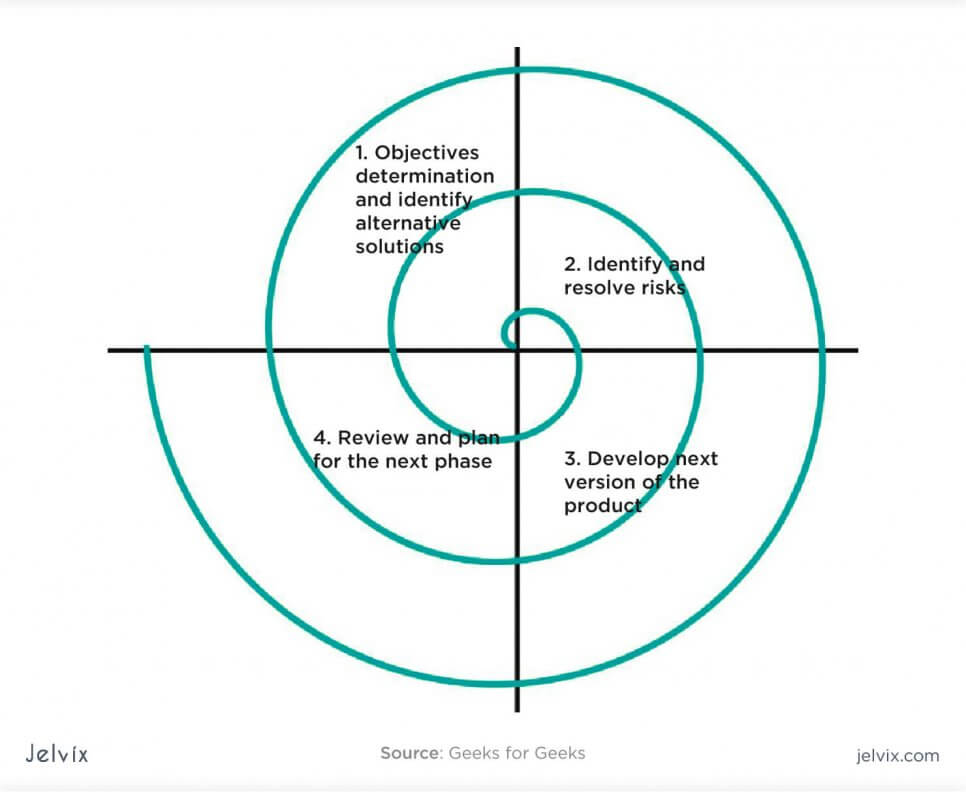Software development methodologies are always a polarizing topic. Choosing a way to organize and manage the project isn’t an easy task – too many individual variables depend on the type of the team and the project.
In this post, we won’t aim to single out the best methodology in software development. This approach simply doesn’t work – it’s up to you and your team to decide. So, we’ll do something better – reviewing the most common software development strategies and looking at the benefits and drawbacks.
Let’s start with the key points, shall we?
What is a Software Development Methodology?
Software development methodology implies dividing the workload into specific segments for its faster management. It also describes management methods used to increase the delivery efficiency, cooperation between development, design, testing, and other teams, as well as the product owner. SDLC methodologies also regulate the participation of involved parties outside the team, like clients and stakeholders. Project participants know how and when to control the project without interfering with the team.
Each methodology features a set of metrics and critical thresholds that showcase the team’s efficiency. Also, the last but not least – methodology isn’t just a set of instruments but a mindset for digital transformation.
What is a Software Development Process?
The software development process unites several stages of product conception and execution. The most common are the following components of the process – idea generation, idea screening, concept development, marketing strategy development, business analysis, product development, test marketing, commercialization.
Knowing this process is important because you must to determine which parts of the software development process your methodology will apply to. Some only use methodologies for development and testing, whereas others also use it during ideation and screening.
The Most Common Software Development Methodologies
There are at least 20-30 software development models out there. Some share key differences, like Agile and Waterfall, while others only vary in insignificant aspects. Here’s our ultimate review.
Waterfall
Waterfall is a model that advocates an organized, predictable approach. It requires completing one stage before starting the next one.
Stages of Waterfall development
The critical thing to remember is that the exact number and names of Waterfall development stages vary depending on the project needs and the team’s vision. Here’s a list of typical phases of Waterfall development.
- Gathering requirements: this is the stage where the team defines the product’s functionality, interface, performance, checks its connection to business goals.
- Design: software development teams pick tech stacks, determine the databases that they prefer, and prepare the technology. UX and UI designers define user personas and create the interface.
- Build: developers write code for software functionality (user-end and server-end).
- Deployment: the code is tested and uploaded to the server.
- Maintenance: the team supports the final version of the application.
Advantages
- he waterfall model is natural to measure and control. The workflow is organized in clearly defined stages, and there is no switching back and forth. Thus, you can set the timing precisely and plan the budget accordingly;
- Management is easy: due to its definite structure, it’s perfect for small teams and inexperienced managers;
- Onboarding is faster: new developers can quickly get up to speed with the project because all the stages logically follow each other.
Disadvantages
- Lack of flexibility: the team can’t fix issues left over from the previous stage, which leads to piled-up bugs and technical debt;
- Collaboration issues: different teams do not work together. If something goes wrong, developers, designers, and testers are likely to blame each other for the failure.
Agile
Agile is a constant repetition of development and testing stages in software development. The project is flexible because developers, designers, and testers cooperate with each other and can perform tasks simultaneously.
Agile process model in software engineering is based on the following fundamental manifesto, which is defined by four values:
- Priority is given to individual interactions over tools and processes – people come first;
- Collaboration over negotiation: the team strives to find the compromise with the product owner, not to negotiate the best one-sided contract;
- Changes over planning: long-term goals are respected but pushed aside if needed.
- Product over complete documentation: developers should spend more time writing code than reports.
Advantages
- Flexibility: if there’s a mistake in project requirements, it can be fixed at any moment, preventing the team from doing unnecessary work. The same applies to any stage.
- Multiple product operations: software is released often but with small changes.
Disadvantages
- Less control: you can’t estimate the project cost early on. Negotiations with product owners become more complicated because the team can’t create a precise estimate or give certain budget guarantees.
- More commitment from the team: developers, testers, and designers should communicate with each other and management.
Prototype Methodology
The name explains the central concept of the methodology well-enough. This test version only features essential functionality and interface, which are enough to showcase the purpose of the product and business model.
Characteristics of the prototype methodology
- The project starts with defining requirements for the final product and the ultimate business model. Then, they are stripped down to the minimal version, leaving only characteristics that are necessary for the execution of essential features.
- The minimal viable product is conceptualized and designed. UX designers analyze the target audience for the project, whereas UI designers select actual graphic elements.
- The build stage. Developers create code for the basic backend and frontend functionality.
- Beta-testing. The MPV is released to a small group of users who evaluate the functionality and detect bugs.
After users evaluate the prototype, the team analyzes the feedback and creates the product’s next iteration.
Advantages
- Quick consent validation: product owners can test if the idea is well received by users and check if the niche has potential;
- Users contribute early on: collecting additional opinion on the project early on helps developers to focus on the most noticeable improvements and track bugs;
- Time- and resource-efficiency: the team focuses on the necessary simple functionality that isn’t expensive to develop. If the concept wasn’t well-received, the product owner didn’t have to spend so many resources on the project.
Disadvantages
- Releasing a defective product to the market: users can be disappointed by the prototype and validate the entire business plan. A product owner will consider this a failure and close the product, even though it could’ve been just a problem of a wrong prototype.
- Skills: it’s better to cooperate with a team that has expertise in MVP development and knows how to build and market a prototype.
Rapid Application Development (RAD)
RAD is similar to the Agile and prototype model. Like these software engineering methodologies, it emphasizes the importance of building a minimum viable product, but also, it prioritizes the speed of the delivery over other metrics. Developers should quickly release new interactions of the product without being overly perfectionist. The regular prototype model doesn’t impose such restrictions.
Similarities between Agile and prototype
- Developers are focused on creating the main functionality first, releasing the product and then perfecting it;
- Testing isn’t as important early on the project;
- Flexibility is prioritized over planning, just like in Agile.
Advantages
- Early feedback: users and stakeholders can evaluate the prototype early on and contribute to the project with their opinions;
- Flexibility: developers can change product requirements and deliverables anytime;
- Quick results: having a done product is better than aiming to release a perfect one without showing tangible results.
Disadvantages
- Rapid application development and rapid application methodologies, with their emphasis on the time of delivery, can lead to the quick-and-dirty approach;
- Management difficulties: product managers need to continually control the process, track tangible results, and monitor the quality of iterations
Dynamic System Development (DSDM)
The DSDM methodology considers the product a complex system, not just a collection of features or code files. Each software is evaluated in terms of tangible value that it brings to businesses. The key priority of the development team is to understand how business works, define clear strategies and objectives, and reflect these goals in the business logic of the application.
To be clear, systems development methods don’t have to be standalone. DSDM can be combined with Agile, prototype development, or rapid development. However, the priorities have shifted towards analyzing business, getting a strategic understanding, and doing in-depth market research.
DSDM comprises five key stages: feasibility study, business research, functional model ideation, system design, and implementation. As you can tell, the majority of these stages fall in the first half of the product development process. DSDM emphasizes on making sure that the product can bring expected benefits to the company and market.
Advantages
- The first stages don’t require in-depth knowledge of software development;
- Provides product owners and software developers with strategic information that will be necessary during product development, marketing, and support;
- Time- and cost-efficient: researching and analyzing isn’t as expensive as executing and testing. Product owners can eliminate questionable concepts early on and avoid wasting time and resources on their prototyping.
Disadvantages
- Time-consuming initial stages: if your team implements DSDM, be ready that the first research stage will take quite a lot of time;
- Documentation: usually, DSDM software development approaches entail presenting product owners with multiple reports and research documents;
- Difficult to manage: not all development teams know how to analyze concepts and control employee’s efficiency of performing such analytical tasks.
Spiral Methodology
The spiral model isn’t a standalone methodology – it can be used with Agile, Waterfall, Prototyping, RAD, and even DSDM. The model’s purpose is to provide the visualization and detailed descriptions of all risks associated with the software products.
- Spiral software development methods follow the standard product development process – only for each stage, involved parties need to present partners and product owners with the rundown of likely risks with a probability evaluation.
- Each project is completed in loops. Similar to sprints and test points, loops of spiral methodology define the task or a cluster of tasks that a team will work on during a given period. The more complex the project is, the more loops it needs.
- The riskier the project is, the higher will be the number of loops. Putting too many risks in a single loop is not recommended.
The process of risk identification never stops. At each stage of product development and for each new product iteration, the team has to identify and resolve potential issues and plan the subsequent steps.
Advantages
- Security assurance: product developers and owners understand possible difficulties and have contingency plans;
- Facilitated management of large projects: when the stakes are high (a lot of stakeholders are involved in the project, and there’s high potential reputation damage), thorough risk assessment during the entire product development helps prevent an unexpected crisis.
- Flexibility: the risks are analyzed at each development stage, which helps to keep in touch with economic trends.
Disadvantages
- Complicated: the methodology requires highly-developed analytical skills;
- Expensive: determining risks on each development stage takes a lot of productive time, which increases the final cost of the product;
- Difficult management-wise: the project manager can have trouble evaluating and monitoring the efficiency of risk assessment since it’s hard to quantify.
Extreme Programming (XP)
Extreme programming is a test-driven software development methodology. The code can’t be considered perfect until the team didn’t run the tests of all system modules. Extreme programming heavily relies on unit testing: after a piece of code is developed, its quality needs to be checked immediately.
It’s evident that extreme programming requires QA and development teams to run thousands of tests every day. To make this work, the team has to adopt automated testing. The priority should be to invest the time at early project stages to automate functional, performance, and unit tests, and save time later on during the QA and maintenance stages.
Fundamental principles of the methodology
- Software requirements and metrics are constantly evolving;
- Developers and testers invest a lot of time in automation and metrics;
- The development team is small – the emphasis is placed on testing and operations;
- Automation is a priority: everything that can be automated shouldn’t be done manually.
Advantages
- Time and cost-efficient: the team doesn’t waste time on rewriting functionality and eliminating bugs or technical debt;
- No need to refactor: the code is evaluated as it’s being written;
- Better performances: users don’t see functionality or interface bugs in the ready project;
- Reduced risks: due to constant monitoring, the team minimizes the risk of sudden system failures.
Disadvantages
- The lack of universality: a strict approach to quality assurance can limit developers’ creativity, pushing them to develop error-free solutions rather than innovative ones;
- Investment in testing: product owners need to be ready to invest additional budgets into testing execution and management.
Systems Development Life Cycle (SDLC)
The systems development life cycle is a conservative system that is heavily based on the stages of the product development process. It’s similar to Waterfall – you can’t jump from one step to another or return to the completed stage.
The main difference is that SDLC is more regimented: while Waterfall allows multiple variations of the names and structure of the development process, SDLC follows an organized approach. It’s not just the set of values – like the majority of methodologies here – but a set algorithm.
It’s somewhat similar to dynamic system development in a sense that it also views products as complex systems, inseparably connected to business goals and strategy. Here ideation and research also take a lot of time, but ultimately, pay off later on.
The main stages of the systems development life cycle
- Analytics: the product owner and development team evaluate the existing tech solutions, define issues, and identify solutions.
- Planning: the development process is planned in detailed, with precise estimates on time and budget;
- Design: the system is evaluated by UX designers who create user personas, define the scope of the product, and refine main characteristics. UI designers implement this vision in interfaces and graphic elements;
- Development: the software is developed, firstly the essential functionality, later – additional features;
- Quality Assurance: testers verify the performance of the software and compare it to requirements, set in the beginning;
- Deployment: the ready product is uploaded to the server where it’s available to end-users;
- Maintenance: after the product was released, the team maintains the codebase and prepares new releases.
Advantages
- Defined algorithm: project managers and team members know exactly which system development methods to follow;
- Easy to measure: project managers can assign metrics to each development stage in advance, knowing that the structure of the workflow won’t be much affected in the process;
- Developers know exactly what their responsibilities entail: there’s less confusion with unrealistic expectations.
Disadvantages
- No flexibility: even though some projects can require the introduction of innovative development stages, the methodology doesn’t take it into account.
- Tech debt and stockpiled complications: code errors and hardware problems tend to accumulate, making maintenance a lot harder.
Accelerate your business success with an IT partner that streamlines operations, enhances scalability, and powers digital transformation.
How to Choose a Development Methodology for my Project
It should be clear by now that software methodologies are very different. Each methodology works within a particular system of priorities, varying degrees of flexibility, and specific deliverables. There’s no such thing as good or bad software development methodology types – it all depends on the project. Let’s take a look at factors that should be considered before you make the final choice.
Consider the Product’s Scope
You need to understand the goals of the project: what is the main task that the final solution will accomplish? What audience does the product target? The software can require constant updates – whether it’s a community-based marketplace or a software-as-a-service. Small websites and landing pages, on the other hand, don’t depend on users as much – so they can be developed with more conservative and less flexible methodologies.
Define Product Requirements
The crucial part of selecting an application development methodology is determining what stages it will entail. For that, you need to create a list of software requirements – describe the ideal functionality, interface, positioning, and results (number of visits, downloads, and others).
Identify the Target aAudience
Some audiences are more conservative and don’t like it when their solutions are updated too often. We’ve all seen complaints on App Store or Google Play that went on about unsolicited updates and uncomfortable new interfaces. Some users don’t like to accommodate new features and design – this should be taken into account when you plan the development process.
Other users (usually the tech-savvier ones) prefer working with a regularly updated solution. They like to see that the product is improving and know what they are paying for. In this case, it’s better to go with Agile or prototyping – flexible methodologies that allow releasing multiple product iterations.
Consider Your Team’s Location and Previous Experience
If your organization is remote, you need to consider the communication practices that they used before. Usually, remote developers work with Agile, Waterfall, and prototyping – these methodologies are the most common ones, and they are also easy to implement.
If the team lacks experience with your type of projects or tech stack, don’t complicate the process by choosing rare mythology (like extreme programming). If the project is challenging, it’s better to stick with the methods of the team’s choice.
Conclusions
A software methodology is not just an algorithm of actions or a collection of tools. It’s a system of beliefs and values that will be applied on a long-term basis. Choosing one is an important decision that sets your project up for success. It’s worth putting investing your time into researching each methodology in the context of your project’s requirements. Also, don’t forget to consult software development experts – a team can give you a new perspective, based on years of experience.
If you have a project in mind and want to choose the right development methodology, consult the Jelvix development team. We are happy to share our insights and experience in organizing and managing software development, testing, and maintenance.





















